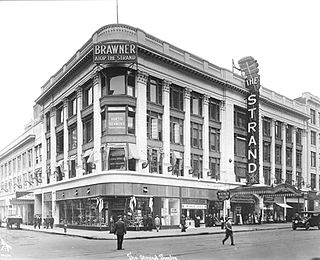
Cinerama is a widescreen process that originally projected images simultaneously from three synchronized 35mm projectors onto a huge, deeply curved screen, subtending 146-degrees of arc. The trademarked process was marketed by the Cinerama corporation. It was the first of several novel processes introduced during the 1950s when the movie industry was reacting to competition from television. Cinerama was presented to the public as a theatrical event, with reserved seating and printed programs, and audience members often dressed in their best attire for the evening.

Samuel Lionel "Roxy" Rothafel was an American theatrical impresario and entrepreneur. He is noted for developing the lavish presentation of silent films in the deluxe movie palace theaters of the 1910s and 1920s.

The Cinerama Dome is a movie theater located at 6360 Sunset Boulevard in Hollywood, California. Designed to exhibit widescreen Cinerama films, it opened November 7, 1963. The original developer was William R. Forman, founder of Pacific Theatres. The Cinerama Dome continued as a leading first-run theater, most recently as part of the ArcLight Hollywood complex, until it closed temporarily in March 2020 due to the COVID-19 pandemic in California. The ArcLight chain closed permanently in April 2021, with the theater never having reopened. In June 2022, it was announced that there were plans to reopen it and the former ArcLight Hollywood under a new name, Cinerama Hollywood.

Goldwyn Pictures Corporation was an American motion picture production company that operated from 1916 to 1924 when it was merged with two other production companies to form the major studio, Metro-Goldwyn-Mayer. It was founded on November 19, 1916, by Samuel Goldfish, an executive at Lasky's Feature Play Company, and Broadway producer brothers Edgar and Archibald Selwyn, using an amalgamation of both last names to name the company.
Smell-O-Vision is a system that released odor during the projection of a film so that the viewer could "smell" what was happening in the movie. Created by Hans Laube, the technique made its only appearance in the 1960 film Scent of Mystery, produced by Mike Todd Jr., son of film producer Mike Todd. The process injected 30 odors into a movie theater's seats when triggered by the film's soundtrack.
A roadshow theatrical release or reserved seat engagement is the practice of opening a film in a limited number of theaters in major cities for a specific period of time before the wide release of the film. Roadshows would generally mimic a live theatre production, with an upscale atmosphere as well as somewhat higher prices than during a wide release. They were commonly used to promote major films from the 1920s–60s and build excitement.
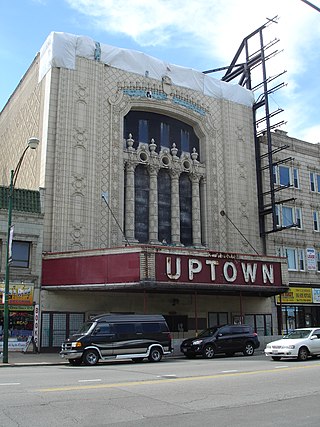
A movie palace is a large, elaborately decorated movie theater built from the 1910s to the 1940s. The late 1920s saw the peak of the movie palace, with hundreds opening every year between 1925 and 1930. With the advent of television, movie attendance dropped, while the rising popularity of large multiplex chains in the 1980s and 1990s signaled the obsolescence of single-screen theaters. Many movie palaces were razed or converted into multiple-screen venues or performing arts centers, though some have undergone restoration and reopened to the public as historic buildings.
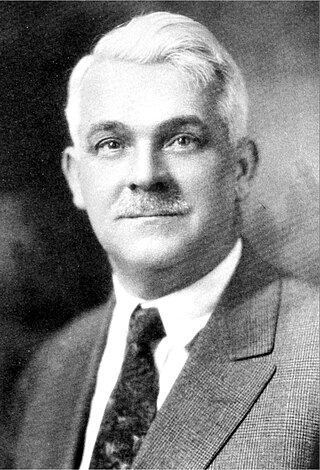
Thomas White Lamb was a Scottish-born, American architect. He was one of the foremost designers of theaters and cinemas of the 20th century.
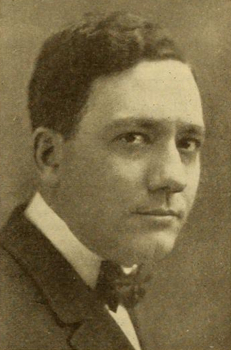
Terry Ramsaye was a journalist, film producer and film historian, the author of A Million and One Nights: A History of the Motion Picture [Through 1925].

Ernö Rapée was a Hungarian-born American symphonic conductor in the first half of the 20th century whose prolific career spanned both classical and popular music. His most famous tenure was as the head conductor of the Radio City Symphony Orchestra, the resident orchestra of the Radio City Music Hall, whose music was also heard by millions over the air on the radio program Radio City Music Hall of the Air.
The Center Theatre was a theater located at 1230 Sixth Avenue, the southeast corner of West 49th Street in Rockefeller Center in New York City. Seating 3,500, it was originally designed as a movie palace in 1932 and later achieved fame as a showcase for live musical ice-skating spectacles. It was demolished in 1954, the only building in the original Rockefeller Center complex to have been torn down.

The Roxy Theatre was a 5,920-seat movie palace at 153 West 50th Street between 6th and 7th Avenues, just off Times Square in New York City. It was the largest movie theater ever built at the time of its construction in 1927. It opened on March 11, 1927 with the silent film The Love of Sunya starring Gloria Swanson. It was a leading Broadway film showcase through the 1950s and also noted for its lavish stage shows. It closed and was demolished in 1960.
Mitchel H. Mark, a.k.a. Mitchell Mark a.k.a. Mitchell H. Mark, was a pioneer of motion picture exhibition and movie theaters in the United States.
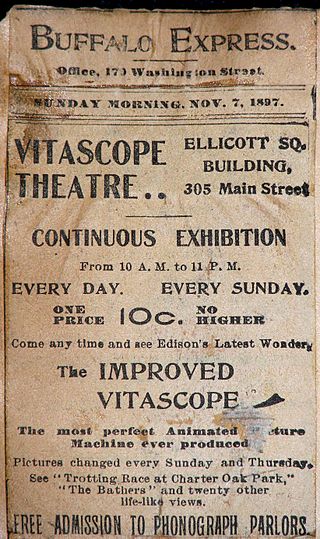
Edisonia Hall was a generic name for exhibition halls that displayed the various inventions of Thomas Alva Edison's company. These included the phonograph, the Vitascope, the Kinetoscope and other such devices.
Moe Mark was the brother of Mitchel H. Mark. Together they opened the first known permanent, purpose-built motion picture theater in the world, Vitascope Hall a.k.a. Vitascope Theater or Edisonia Hall in 1896 Buffalo, New York, and the first movie palace, the Strand Theatre (1914) in New York City. They founded Mark-Strand chain of theaters which operated dozens of theatres in the United States. His brother died in 1918. In 1926, Mark sold part of the chain to Stanley Company of America and in 1929, he sold the remainder to Warner Brothers which had purchased the Stanley Company in 1928. In 1953, Warner's theater holdings were spun off as Stanley Warner Theaters and in 1967 merged with RKO Theatres to become RKO-Stanley Warner Theatres.

The Mainstreet Theater, also commonly referred to as The Empire Theater, is a historic theater in downtown Kansas City, Missouri in the Power & Light District. The theater was landmarked and placed on the National Register of Historic Places in February 2007.

Hollywood Pacific Theatre, also known as Warner Theatre, Warner Bros. Theatre, Warner Hollywood Theatre, Warner Cinerama, Warner Pacific, and Pacific 1-2-3, is a historic office, retail, and entertainment space located at 6433 Hollywood Boulevard in Hollywood, Los Angeles, California. It is best known for its movie theater, which was owned by Warner Bros. from 1928 to 1953, Stanley Warner Theatres from 1953 to 1968, and Pacific Theatres from 1968 to 1994.

The Capitol Theatre was a movie palace located at 1645 Broadway, just north of Times Square in New York City, across from the Winter Garden Theatre. Designed by theater architect Thomas W. Lamb, the Capitol originally had a seating capacity of 5,230 and opened October 24, 1919. After 1924 the flagship theatre of the Loews Theatres chain, the Capitol was known as the premiere site of many Metro-Goldwyn-Mayer (MGM) films. The Capitol was also noted for presenting live musical revues and many jazz and swing bands on its stage.

The Rialto Theatre was a movie palace in New York City located at 1481 Broadway, at the northwest corner of Seventh Avenue and 42nd Street, within the Theater District of Manhattan.

This article delineates the history of cinema in the United States
